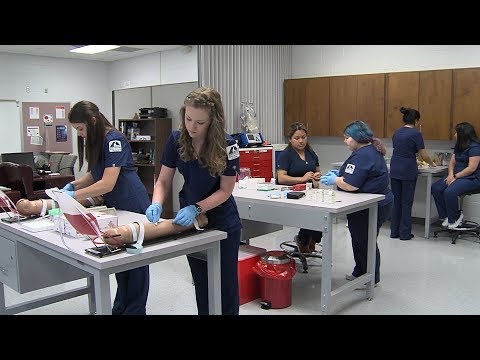The Many Responsibilities of a Medical Assistant
Contents [show]
A medical assistant is a trained professional who helps to keep doctors’ offices and clinics running smoothly. They have many responsibilities, from greeting patients to scheduling appointments to handling insurance paperwork.
Checkout this video:
Job Description
Medical assistants are multi-skilled health professionals specifically trained to work in outpatient settings such as medical offices and clinics. JOB DESCRIPTION They perform both clinical and administrative tasks and often serve as a patient’s main point of contact with the medical office.
Clinical tasks for Medical Assistants can include but are not limited to:
– taking and recording vital signs
– handling blood specimens
– preparing patients for examination
– performing basic laboratory tests
– giving injections
Administrative tasks can include but are not limited to:
– scheduling appointments
– handling billing and insurance paperwork
– coding and filling out insurance forms
– maintaining patient records
Medical assistants must be able to perform both sets of duties, as well as interact with patients in a respectful and professional manner. They must also possess strong organizational skills and be detail oriented, as accuracy is crucial in the healthcare field.
Medical Assistant Duties
A medical assistant performs a variety of duties in a doctor’s office or other medical facility. Many of these duties are administrative, such as answering phones, scheduling appointments, and processing insurance forms. They may also be responsible for taking and recording patient medical histories and vital statistics. In some states, medical assistants are allowed to perform basic laboratory tests and give injections under the supervision of a physician. Medical assistants must have excellent communication skills, as they often act as a liaison between patients and doctors. They must also be able to handle sensitive information with discretion.
Training and Education
A medical assistant is a vitally important member of any healthcare team. Providing both clinical and administrative support, medical assistants perform a wide variety of tasks in hospitals, clinics, and doctor’s offices. As the demand for qualified healthcare professionals continues to grow, so does the demand for well-trained medical assistants.
If you’re thinking about a career in medical assisting, you’re probably wondering what kind of training and education you’ll need. The good news is that you can get started on your path to becoming a medical assistant relatively quickly. Most programs can be completed in less than two years, and many students are able to find entry-level positions even before they complete their formal education.
While there are no formal educational requirements to become a medical assistant, most employers prefer to hire candidates who have completed an accredited program. Medical assistant programs are widely available at community colleges, vocational schools, and even some four-year institutions. These programs typically include both classroom instruction and hands-on experience in a clinical setting.
Coursework in a medical assistant program may include anatomy, physiology, Medical Terminology office procedures, computer applications, insurance billing and coding, laboratory procedures, and patient care techniques. Students will also have the opportunity to gain experience performing tasks such as taking patient vital signs, preparing exam rooms, administering injections and vaccinations, collecting lab specimens, scheduling appointments, and handling basic office duties.
After completing a medical assistant program, many students choose to earn certification through an organization such as the American Association of Medical Assistants or the National Healthcare Association. Although certification is not required for employment as a medical assistant, it may give candidates a competitive edge when applying for jobs. Employers often view certification as evidence of a commitment to professional development and excellence in the field.
Medical Assistant Salary
Medical assistants are responsible for providing patient care, taking and recording medical histories and vital signs, scheduling appointments, verifying insurance and coding, preparing patients for examination, performing basic laboratory tests and assisting with minor office surgery. They also may educating patients about their condition or self-care instructions. Medical assistants keep doctors’ offices, clinics and other healthcare facilities running smoothly.
The median annual salary for medical assistants was $34,800 in May 2018. The top 10 percent earned more than $49,380, and the bottom 10 percent earned less than $24,560. Median wages (those in the middle of the salary range) are a good way to compare salaries for different occupations.
Most medical assistants work full time. Because many offices are open during evenings or weekends, some medical assistants may have to work evenings or weekends.
Job Outlook
The U.S. Bureau of Labor Statistics projects that employment of medical assistants will grow much faster than the average for all occupations between 2016 and 2026, at a rate of 29 percent. This is mainly due to an aging population and advances in medical technology, which require more medical procedures and tests, many of which will be performed by medical assistants. The growth of walk-in clinics and other “convenience” care centers is another reason for the projected increase in demand for medical assistants. The American Association of Medical Assistants reports that as nursing homes physician’s offices, HMOs, and group practices continue to proliferate, medical assistants will be needed to staff them.
Medical Assistant Certification
Medical assistants play a vital role in the healthcare industry. They are thelink between patients and doctors, and they perform a variety of clerical,administrative, and clinical tasks. Many medical assistants are certified,which means they have completed an accredited medical assistant programand have passed a certification exam.
Becoming certified is voluntary, but it shows employers that you have theknowledge and skills needed to be a successful medical assistant. If youare certified, you may have better job prospects and earn a higher salarythan non-certified medical assistants.
There are several different medical assistant certification exams offered bydifferent organizations. The most popular exam is offered by the AmericanAssociation of Medical Assistants (AAMA). To be eligible to take thisexam, you must have graduated from an accredited medical assistantprogram. Once you pass the exam, you will earn the Certified MedicalAssistant (CMA) credential.
Other popular certification exams include the National HealthcareerAssociation (NHA) Certified Clinical Medical Assistant (CCMA) exam andthe National Center for Competency Testing (NCCT) National CertifiedMedical Assistant (NCMA) exam. To be eligible to take either of theseexams, you must have graduated from an accredited medical assistantprogram or have at least five years of work experience as a medicalassistant.
Once you pass one of these exams, you will earn either the CCMA or NCMACredential, respectively. There are also state-specific certificationsavailable in some states. These certify that you meet your state’srequirements for medical assistants and that you are qualified to work inthat state. Check with your state’s medical board to see if this option isavailable.
Medical Assistant Jobs
A medical assistant is a key member of the healthcare team. Medical assistants play a vital role in providing patients with quality care and customer service. They are often the first point of contact for patients, and they play a vital role in maintaining a smooth flow of communication between patients and doctors.
Medical assistants have a wide variety of responsibilities, ranging from administrative duties to clinical tasks. They may be responsible for scheduling appointments, verifying insurance coverage, preparing patients for examinations, and collecting medical histories. Additionally, medical assistants may also take and record vitals signs, assist with minor surgeries or procedures, administer injections, prepare and maintain exam rooms, and instruct patients on taking medications.
With such a wide range of responsibilities, medical assistants must be highly organized and detail-oriented. They must be able to multitask and prioritize their workloads effectively. excellent communication skills are also essential, as medical assistants must be able to interact with patients, doctors, and other members of the healthcare team on a daily basis.
Medical Assistant Schools
Medical assistant schools offer curriculum that covers both the clinical and administrative duties of a medical assistant. A student in one of these programs can expect to receive training in various medical office procedures, including but not limited to patient intake, medical records management, coding and billing, and scheduling. In addition, students will also receive hands-on training in basic medical procedures such as taking vital signs, administering injections, and performing blood draws. A clinical externship is usually required in order to graduate from a medical assistant program.
Medical Assistant Programs
Medical Assistant Programs vary in length, but most students complete their studies within two years. These programs provide the necessary training to become a certified medical assistant and prepare students for their future roles in the healthcare industry.
During their studies, medical assistant students learn how to perform basic medical tasks such as measuring vital signs and administering injections. They also receive instruction on more complex topics such as patient care, anatomy and physiology, and medical office procedures. In addition to classroom learning, medical assistant programs include clinical rotations that give students the opportunity to apply their knowledge in a real-world setting.
After completing a medical assistant program, graduates are prepared to take on a variety of responsibilities in healthcare settings. Medical assistants may work in doctor’s offices, clinics, hospitals, or other healthcare facilities. They may be responsible for scheduling appointments, taking patient histories, arranging for laboratory tests, and assisting with minor surgical procedures. In addition to performing administrative tasks, medical assistants may also be responsible for direct patient care, such as providing wound care or administering medication.
Medical assistants play a vital role in the healthcare industry and are an important part of the care team. With their combination of clinical and administrative skills, medical assistants are able to make a positive impact on the lives of patients and families every day.
Medical Assistant Exams
There are several different types of exams and tests that a medical assistant may be responsible for administering. These can include physical exams, immunizations, electrocardiograms (EKGs), and vision and hearing tests. The medical assistant may also be responsible for collecting and processing lab specimens, as well as performing basic lab tests. Additionally, the medical assistant may help to prepare patients for X-rays and other diagnostic procedures.







